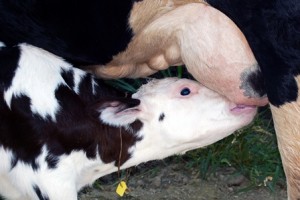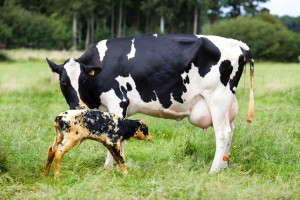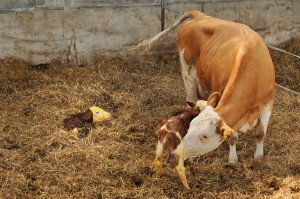Cattle Diseases
Colibacillosis
Also known as: E. coli infection, ETEC, Septicemic Colibacillosis
- Inadequate or unsuccessful passive immune transfer of antibodies from the dam to calf
- Exposure to the pathogen before colostrum was ingested, immediately after birth
- Inclement weather
- Use of milk replacers as opposed to whole milk
- Poor hygiene, especially in calving pens (Groutides and Michell, 1990).
What causes Colibacillosis?
Control and Prevention
Treatment Options
Colibacillosis and Welfare
Good Practice
Three groups of E. coli bacteria have been associated with diarrhea in calves. The most common are enterotoxigenic E. coli (ETEC). Enteropathogenic and enterohemorrhagic types are also common but are non-pathogenic to cattle, including the verocytotoxic (VTEC) forms that cause severe illness in humans such as E. coli 0157. The VTEC have been isolated from calves with diarrhea (10% of diarrhea calves less than 2 weeks old) but were also found in non-diseased calves (16% of animals tested), therefore although EHEC 0157 may be associated with neonatal diarrhea, it is also carried asymptomatically by many animals (Kang et al., 2004).

Passive transfer of maternal antibodies from the dam in the colostrum is really important in reducing risk of colibacillosis in young stock
ETEC cause diarrhea in very young calves, less than 3-4 days of age (typically less than 48 hours of age). Calves are depressed, do not drink or suckle, become dehydrated, and die rapidly. Very profuse and watery diarrhea is typical of ETEC scours.
Diarrhea caused by enterotoxigenic E. coli (ETEC) occurs in outbreaks in herds where the pathogen has been introduced and susceptible calves are present. Inadequate intake of colostrum and absorption of antibodies is the main reason for susceptibility. ETEC diarrhea in calves has also been associated with the presence of viral scour pathogens, rotavirus and coronavirus ((LINK)).
Sepeticemic colibacillosis, caused by another serotype of ETEC, is an acute disease with very few diagnostic signs and is the most common cause of acute, fatal illness in neo-natal calves. Depressed, weak animals initially have a fever but become hypothermic rapidly. Mortality rates are high and survivors are often affected by post-septicemic localisation of infection in the form of arthritis, meningitis or pneumonia. Inadequate transfer of passive immunity from the dam is considered the main risk factor for colibacillosis (Aldridge et al., 1993; Fecteau et al., 1997).
Control and Prevention of Colibacillosis
The passive immunity acquired from the colostrum and absorbed into the circulation from the gut is the calf’s main defense mechanism against E. coli diarrhea. Inadequate amounts of antibodies in the colostrum, inadequate intake of the colostrum and inadequate absorption of antibodies from the gut render very young calves susceptible to infection (Groutides and Michell, 1990). Additionally, among calves aged 1-4 months old, carriage of VTEC E. coli O157 was reduced if the calf had suckled colostrum from the mother or if the calf had stayed more than 2 days with the mother after calving (Rugbjerg et al., 2003).
For herd where a known infection is present an improvement in colostrum feeding in the first 6-9 hours of life and dam immunization against ETEC E. coli F5 (K99) adhesin (Rotavec Corona, Schering Plough Animal Health, Lactovac, Zoetis Animal Health, Trivacton 6, Merial Animal Health) are the main ways of controlling disease. The disease can be reduced by the use of dam vaccine before calving, improved hygiene around calving and improved colostrum administration (Cornaglia et al., 1992; Snodgrass, 1983).
Where the disease is absent from the herd, the prevention should concentrate on keeping it out by good herd biosecurity.
Intestinal microflora balance has been reported to be improved in calves fed on green tea extracts in one experimental study (Ishihara et al., 2001). These are experimental results only and are not available commercially.
Treating Colibacillosis
This disease requires an immediate response, centered on isolation and rehydration therapy. Parental antibiotics can be useful if given early, but not without rehydration therapy. In calves with diarrhea and no systemic illness (normal appetite and no fever) antimicrobials are not recommended (Constable et al., 1992). Multi-resistant (to antibiotics) strains of E. coli have been identified, and antibiotics should not be the main approach to treatment (Farris et al., 1979). One study has suggested that use of dried oregano leaves, which provides essential oils, may be effective as an oral treatment against colibacillosis (Bampidis et al., 2006). However, this is only experimental work and is, as yet not a commercial option.
Colibacillosis and Welfare
Calf diarrhea is one of the main causes of early deaths in calves, and is a major animal welfare concern in dairy herds. The fact that the majority of scouring problems can be avoided by good management adds to the need to tackle calf diarrhea problems if they exist in cattle herds.
The isolation of affected calves, effective treatment with rehydration solutions and the provision of dry and warm conditions are vital in the treatment of calf scours, in order to avoid further suffering. There is evidence to suggest that the addition of antibiotics to the rehydration solution does not improve recovery. The use of oral antibiotics should be carefully avoided in the case of undiagnosed outbreaks of calf scours to avoid further disruption of gut flora. If the calf is incapable of drinking the dehydration solution, parenteral rehydration has to be provided.
Septicemic colibacillosis is a major cause of early calf deaths. The condition is often fatal or leads to post-septicemic infections that are often non-responsive to treatment. If an outbreak occurs, every effort should be made to isolate the affected calves immediately. If the cause of the condition is known, systemic antibiotic and anti-inflammatory therapy can be helpful.
Good Practice based on Current Knowledge
Good practice to control and prevent ETEC infection can be divided into two main areas of action:
- Maintenance of immune status, and
- Minimization of exposure to the agent
Maintenance of immune status

Calves should not be separated from their mothers too early to ensure they receive adequate colostrum to enable the transfer of maternal antibodies.
- Provide adequate bedding to allow the calf to stand without difficulty
- Ensure early feeding, assist if needed, monitor the intake as closely as possible and record it (“maximum supervision, minimum interference”)
- Keep a supply of frozen colostrum in case the dam leaks colostrum before calving
- Outdoor calving
- Feed fresh or fermented colostrum to all calves up to three weeks of age
- In cases where ETEC has been identified as a herd problem, immunize pregnant dams before calving as part of a targeted control plan.
Minimization of exposure
- Provide adequate numbers of calving pens and clean and disinfect them between batches
- House calves well away from the calving pens
- Keep up high hygiene standards throughout the calving period and in calf housing
- Keep the infection out of the herd if not present, by a closed herd policy and the avoidance of visitors from other farms, unless precautions are taken.
If the farm has a known ETEC diarrhea problem, contact the vet and make a plan for eradication and/or improved control by vaccinating dams and improving hygiene and colostrum administration.
If the farm has an undiagnosed continuous calf diarrhea problem, consider the presence of ETEC (severe, profuse diarrhea outbreaks, in very young calves), organize sampling during the next outbreak to identify the causative agent and factors, and make a plan to improve control, as above.
Set up a recording system for individual calf scour cases and outbreaks of scours. A genuinely closed herd will be fairly well protected from ETEC, unless the infection is already in the herd.
Recording notes should include the following:
- Name/number of the calf
- Dates, duration
- Frequency and type of treatment
- Length of the statutory withdrawal period
- Outcome of the treatment (e.g. success/failure)


 British English
British English


Comments are closed.